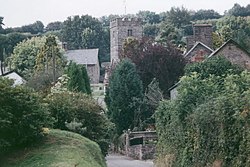Brompton Regis
| Brompton Regis | |
| Somerset | |
|---|---|
 Brompton Regis | |
| Location | |
| Grid reference: | SS955315 |
| Location: | 51°4’24"N, 3°29’35"W |
| Data | |
| Population: | 449 (2011[1]) |
| Post town: | Dulverton |
| Postcode: | TA22 |
| Local Government | |
| Council: | Somerset West and Taunton |
| Parliamentary constituency: |
Bridgwater & W. Somerset |
Brompton Regis (formerly known as King's Brompton) is a village and parish in Somerset, about five miles north-east of Dulverton. It is situated on the River Haddeo in the Brendon Hills within the Exmoor National Park, close to Wimbleball Lake, a water supply reservoir constructed in the 1970s and completed in 1979. According to the 2011 census the village had a population of 449.[1] The parish boundary is marked by the River Exe which is crossed by the medieval Chilly Bridge[2] and Hele Bridge.[3] The Haddeo is crossed by Bury Bridge.[4]
The civil parish encompasses the ancient parishes of King's Brompton and Withiel Florey.
History
Before the Norman Conquest the manor was held by Gytha Thorkelsdóttir and was seized by William the Conqueror. The parish of Withiel Florey forms part of the Taunton Deane Hundred, while Brompton Regis forms part of the Williton and Freemanners Hundred.[5] By the later 12th century Brompton Regis had been granted to William de Say, who founded Barlynch Priory in the west of the parish. In the 13th century it passed to the Besil family who had a motte-and-bailey castle near Bury.[6]
Gupworthy was the terminus of the West Somerset Mineral Railway which ran from the ironstone mines in the Brendon Hills to the port of Watchet on the Bristol Channel.[7]
Bury Bridge over the River Haddeo is a mediæval packhorse bridge. It has been scheduled as an ancient monument and Grade II* listed building.[8][9]
Religious sites
The parish Church of St Mary in Brompton Regis has a 13th-century tower, with the rest of the church being from around 1490.[10]
Gallery
-
Brompton Regis: Redcross Farm
-
The Ancient bridge and ford at Bury
-
Hadborough trig point.
References
| ("Wikimedia Commons" has material about Brompton Regis) |
- ↑ 1.0 1.1 "Statistics for Wards, LSOAs and Parishes — SUMMARY Profiles" (Excel). Somerset Intelligence. http://www.somersetintelligence.org.uk/files/Somerset%20Census%20Key%20Statistics%20-%20Summary%20Profiles.xls. Retrieved 4 January 2014.
- ↑ "Chilly Bridge". Images of England. English Heritage. http://www.imagesofengland.org.uk/Details/Default.aspx?id=265598. Retrieved 29 November 2008.
- ↑ "Hele Bridge". Images of England. English Heritage. http://www.imagesofengland.org.uk/Details/Default.aspx?id=429171. Retrieved 29 November 2008.
- ↑ "Bury Bridge". Images of England. English Heritage. http://www.imagesofengland.org.uk/Details/Default.aspx?id=265615. Retrieved 29 November 2008.
- ↑ "Somerset Hundreds". GENUKI. http://www.genuki.org.uk/big/eng/SOM/Miscellaneous/. Retrieved 23 October 2011.
- ↑ Bush, Robin (1994). Somerset: The complete guide. Wimborne, Dorset: Dovecote Press. p. 46. ISBN 1-874336-26-1.
- ↑ "Station Name: WATCHET". Subterranea Britannica. http://www.subbrit.org.uk/sb-sites/stations/w/watchet/index.shtml. Retrieved 19 November 2007.
- ↑ "MSO8842 - Bury Bridge". Exmoor National Park. http://www.exmoorher.co.uk/hbsmr-web/record.aspx?UID=MSO8842-Bury-Bridge-Bury-Brompton-Regis. Retrieved 7 March 2015.
- ↑ "Bury Bridge at NGR SS 9445 2745". English Heritage. http://list.english-heritage.org.uk/resultsingle.aspx?uid=1263985. Retrieved 7 March 2015.
- ↑ "Church of St Mary Magdalene". Images of England. English Heritage. http://www.imagesofengland.org.uk/Details/Default.aspx?id=265607. Retrieved 29 November 2008.



